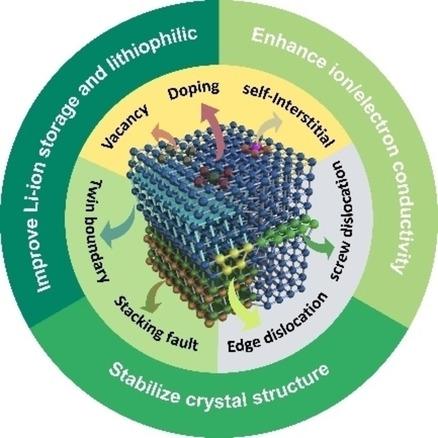当前位置:
X-MOL 学术
›
Chem. Asian J.
›
论文详情
Our official English website, www.x-mol.net, welcomes your
feedback! (Note: you will need to create a separate account there.)
Function and Application of Defect Chemistry in High‐Capacity Electrode Materials for Li‐Based Batteries
Chemistry - An Asian Journal ( IF 3.5 ) Pub Date : 2020-09-27 , DOI: 10.1002/asia.202000904 Zhensong Qiao 1 , Liang Lin 1 , Xiaolin Yan 1 , Weibin Guo 1 , Qiulin Chen 1 , Qingshui Xie 1 , Xiao Han 1 , Jie Lin 1 , Laisen Wang 1 , Dong-Liang Peng 2
Chemistry - An Asian Journal ( IF 3.5 ) Pub Date : 2020-09-27 , DOI: 10.1002/asia.202000904 Zhensong Qiao 1 , Liang Lin 1 , Xiaolin Yan 1 , Weibin Guo 1 , Qiulin Chen 1 , Qingshui Xie 1 , Xiao Han 1 , Jie Lin 1 , Laisen Wang 1 , Dong-Liang Peng 2
Affiliation

|
Current commercial Li‐based batteries are approaching their energy density limitation, yet still cannot satisfy the energy density demand of the high‐end devices. Hence, it is critical to developing advanced electrode materials with high specific capacity. However, these electrode materials are facing challenges of severe structural degradation and fast capacity fading. Among various strategies, constructing defects in electrode materials holds great promise in addressing these issues. Herein, we summarize a series of significant defect engineering in the high‐capacity electrode materials for Li‐based batteries. The detailed retrospective on defects specification, function mechanism, and corresponding application achievements on these electrodes are discussed from the view of point, line, planar, volume defects. Defect engineering can not only stabilize the structure and enhance electric/ionic conductivity, but also act as active sites to improve the ionic storage and bonding ability of electrode materials to Li metal. We hope this review can spark more perspectives on evaluating high‐energy‐density Li‐based batteries.
中文翻译:

缺陷化学在锂基电池大容量电极材料中的作用和应用
当前的商用锂基电池正接近其能量密度极限,但仍不能满足高端设备的能量密度需求。因此,开发具有高比容量的高级电极材料至关重要。然而,这些电极材料面临严重的结构退化和快速的容量衰减的挑战。在各种策略中,在电极材料中构造缺陷在解决这些问题方面具有广阔的前景。在此,我们总结了锂基电池大容量电极材料中的一系列重大缺陷工程。从点缺陷,线缺陷,平面缺陷和体积缺陷的角度讨论了缺陷规范,功能机理以及在这些电极上的相应应用成果的详细回顾。缺陷工程不仅可以稳定结构并增强电/离子导电性,还可以充当活性位点,以改善电极材料与锂金属的离子存储和结合能力。我们希望这次审查能激发更多关于评估高能量密度锂基电池的观点。
更新日期:2020-11-17
中文翻译:

缺陷化学在锂基电池大容量电极材料中的作用和应用
当前的商用锂基电池正接近其能量密度极限,但仍不能满足高端设备的能量密度需求。因此,开发具有高比容量的高级电极材料至关重要。然而,这些电极材料面临严重的结构退化和快速的容量衰减的挑战。在各种策略中,在电极材料中构造缺陷在解决这些问题方面具有广阔的前景。在此,我们总结了锂基电池大容量电极材料中的一系列重大缺陷工程。从点缺陷,线缺陷,平面缺陷和体积缺陷的角度讨论了缺陷规范,功能机理以及在这些电极上的相应应用成果的详细回顾。缺陷工程不仅可以稳定结构并增强电/离子导电性,还可以充当活性位点,以改善电极材料与锂金属的离子存储和结合能力。我们希望这次审查能激发更多关于评估高能量密度锂基电池的观点。










































 京公网安备 11010802027423号
京公网安备 11010802027423号